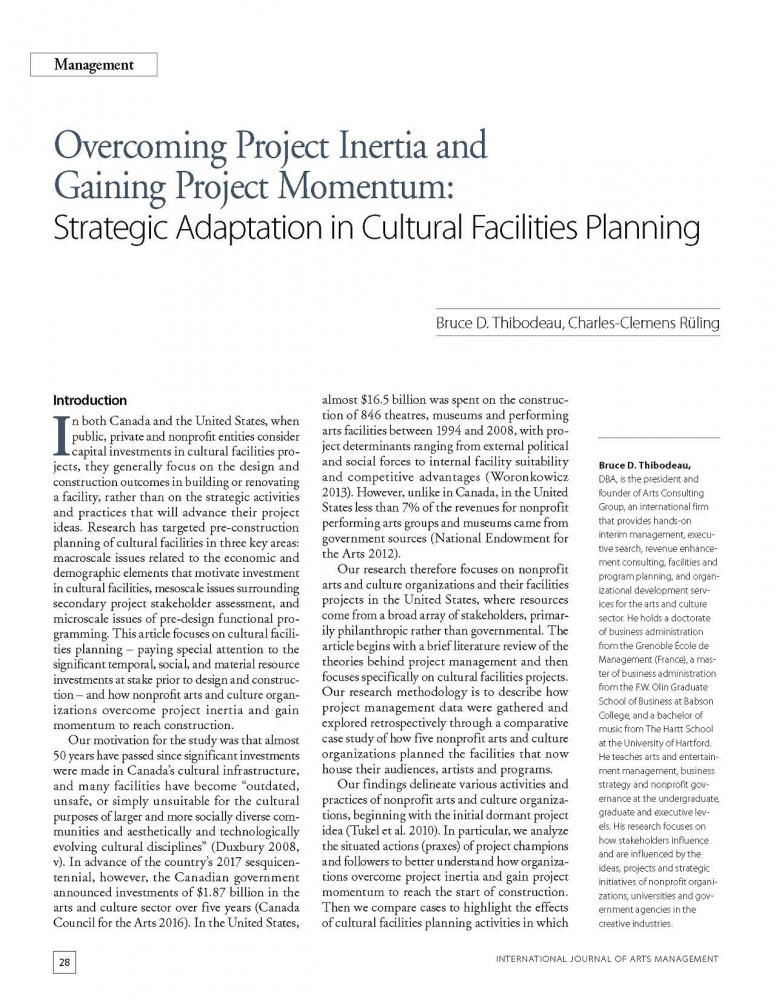Overcoming Project Inertia and Gaining Project Momentum: Strategic Adaptation in Cultural Facilities Planning
Produit: Article
21,00 $ CA
Bruce D. Thibodeau, Charles-Clemens Rüling
Bruce D. Thibodeau, DBA, is the president and founder of Arts Consulting Group, an international firm that provides hands-on interim management, executive search, revenue enhancement consulting, facilities and program planning, and organizational development services for the arts and culture sector. He holds a doctorate of business administration from the Grenoble École de Management (France), a master of business administration from the F.W. Olin Graduate School of Business at Babson College, and a bachelor of music from The Hartt School at the University of Hartford. He teaches arts and entertainment management, business strategy and nonprofit governance at the undergraduate, graduate and executive levels. His research focuses on how stakeholders influence and are influenced by the ideas, projects and strategic initiatives of nonprofit organizations, universities and government agencies in the creative industries.
Charles-Clemens Rüling, PhD, is a professor of organization and management theory. He holds a postdoctoral degree in management (HDR), a doctorate in social and economic sciences, and master’s degrees in sociology and business administration. He is an associate editor at Long Range Planning and a member of the editorial board of M@n@gement. A permanent member of the IREGE research laboratory (Université Savoie Mont Blanc), he also serves as coordinator of the national research consortium Better Business Models. He teaches management, organization theory and research methods at the graduate, postgraduate and executive levels. His research focuses on institutional dynamics, field configuring events and business model innovation.
ABSTRACT
Nonprofit arts and culture organizations face unique challenges as they conceive, develop and finance the facilities that house their programs, artists and audiences. While research on the project management of traditional facilities focuses on procurement, briefing, design and construction of public and commercial structures, the cultural facilities literature delves into the determinants of pre-construction economic investment, value engineering during construction, and the perceived post-opening value of public and nonprofit facilities. There is limited empirical research on how project champions and followers advance cultural facilities from dormant project ideas to the start of construction in nonprofit arts and culture organizations. The authors use a comparative case study approach to examine the activities and practices of five organizations in the planning of their cultural facilities. They augment the theoretical and managerial literature by demonstrating how these projects overcome inertia through project champion practices and gain momentum through activities with project followers to engender project sensemaking and strategic adaptation in cultural facilities planning.
KEYWORDS
Cultural facilities, nonprofit organizations, project management, inertia and momentum
RÉSUMÉ
Les organismes artistiques et culturels à but non lucratif font face à des défis particuliers en concevant, développant et finançant leurs édifices de création et de diffusion. Tandis que la recherche portant sur la gestion de projets traditionnels d’immobilisation se concentre sur l’acquisition et la conception d’édifices publics et commerciaux, la littérature consacrée aux immobilisations culturelles s’est intéressée surtout aux investissements économiques préalables à la construction, à l’analyse de la valeur pendant la construction et à la valeur perçue après l’ouverture. Il existe peu de recherches empiriques sur la façon dont les promoteurs et directeurs de projets font progresser les projets d’édifices culturels jusqu’au stade de la construction. Les auteurs utilisent une approche comparative fondée sur des études de cas afin d’analyser les activités et les pratiques de cinq organismes dans la planification de leurs immobilisations. Ils contribuent à la recherche théorique et managériale en montrant comment ces projets ont vu le jour grâce aux pratiques de gestion innovantes des directeurs de projets et des activités réalisées par les promoteurs qui ont donné du sens et qui ont conduit à une adaptation stratégique de ces projets d’édifices culturels.
MOTS CLÉS
Installations culturelles, organismes sans but lucratif, gestion de projet, inertie et dynamisme
RESUMEN
Las organizaciones artísticas y culturales sin afán de lucro tienen retos particulares en cuanto al diseño, el desarrollo y el financiamiento de las instalaciones donde se ubican sus programas, sus artistas y públicos. Mientras que la investigación sobre las instalaciones tradicionales hace hincapié en el abastecimiento, las instrucciones, el diseño y la construcción de estructuras públicas y comerciales, las publicaciones sobre instalaciones culturales examinan los determinantes de la inversión económica preconstrucción, la ingeniería de valores durante la construcción, y el valor posapertura percibido de dichas instalaciones públicas y sin afán de lucro. Existen escasas investigaciones empíricas sobre la manera en que los líderes y seguidores de los proyectos llevan las instalaciones culturales desde las ideas latentes de proyecto hasta el comienzo de la construcción en el seno de mencionadas organizaciones. Los autores, mediante un estudio comparativo de caso, examinan las actividades y prácticas de cinco organizaciones al planificar sus instalaciones culturales y contribuyen a ampliar las nociones teóricas y de gestión al demostrar cómo estos proyectos superan la inercia con prácticas de liderazgo de proyecto. Se muestra también cómo se genera impulso mediante actividades realizadas con los seguidores de proyecto para crear sentido y adaptar estratégicamente la planificación de instalaciones culturales.
PALABRAS CLAVE
Instalaciones culturales, organizaciones sin afán de lucro, gestión de proyectos, inercia e impulso
